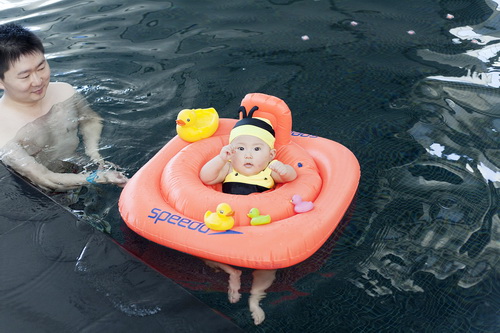Whether you’re home for the holidays, utilizing one of the pool facilities that Beijing offers, or just want to brush up on some hot tips, water safety remains as important as ever (yes – even in these cold months!)
Growing up in Australia has given me a valuable understanding of the importance of water safety – between beachside weekends, weekly swimming lessons, or lazy afternoons spent in a friend’s pool, the “do’s and don’ts” were drilled in from an early age. Having worked as both a lifeguard and a swim instructor has also made me particularly aware of how vulnerable the little ones can be in this area. With drowning as the third leading cause of incidental injury death worldwide as well, we can all afford to brush up some of our knowledge. So what exactly should we keep in mind? Here are some of the basics:
Familiarization:
It’s important to familiarize your child with water of varying depths from an early age; panic in the water can quickly lead to drowning. Many parents find it easier to join their children in the water in order to make it more familiar. It may also be a good idea to involve toys or music to ease the transition. Other ways to increase familiarization is to practice being in the water with clothes on – perhaps practice hopping in with a t-shirt and shorts for the little ones, or treading water for thirty seconds or so for the older ones. This way, should the situation arise that they find themselves in water of a certain depth fully clothed, they are more familiar with it.
Supervision:
It’s important to keep an eye on the kids in the water. This might seem like a bit of an obvious one, but it’s surprising how little time it can take for an accident to happen. No matter how shallow the water is or how experienced the swimmer, having a competent supervisor at all times is a must. This said, having a lifeguard is not a guarantee of safety! Keep an eye too on pool accessories that the children use – whether they are flotation devices, diving rings, or a ball tossed between two children. The latter may cause too much of a distraction, while flotation devices might cause the child to become entangled or pushed underwater. Ensure that any accessories used in the pool are up to a certified safety standard.
Interaction:
Even if your child is a junior Michael Phelps out in the deep end, watching how they interact with others especially is crucial. While playing together in the water is great for making friends and getting some exercise, kids can often distract one another, and group games that are played in the pool are often among the most common ways that incidents and injury occur. One of the most dangerous types of games to be wary of involves holding your breath underwater for as long as possible. Another kind that I saw numerous times as a lifeguard involved diving competitions – this can be particularly dangerous in shallow areas where the risk of head injury is much higher. Another thing to look out for in a group of children is a less competent swimmer’s signs of panic and distress. A less competent swimmer may push down and hold onto the body of another child to remain afloat if they are in a state of panic – resulting in one or both children going below the surface.
Overall, swimming is a great way to exercise and have fun for the whole family. Don’t be worried about the potential dangers – keeping these brief safety tips in mind for a start will have you in the right swimming lane for success!
Photo: Sui




